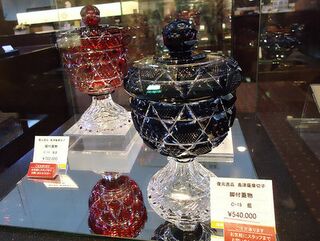Difference between revisions of "Satsuma kiriko"
(Created page with "*''Japanese'': 薩摩切子 ''(Satsuma kiriko)'' Satsuma kiriko is a style of cut glass (''kiriko'') developed and produced in Kagoshima prefecture (formerly, [[Satsuma p...") |
|||
| (One intermediate revision by the same user not shown) | |||
| Line 1: | Line 1: | ||
| + | [[File:Satsumakiriko.jpg|right|thumb|320px|Some examples of ''Satsuma kiriko'' on display at the [[Sengan'en]] Gallery in Kagoshima]] | ||
*''Japanese'': 薩摩切子 ''(Satsuma kiriko)'' | *''Japanese'': 薩摩切子 ''(Satsuma kiriko)'' | ||
| − | Satsuma kiriko is a style of cut glass (''kiriko'') developed and produced in [[Kagoshima prefecture]] (formerly, [[Satsuma province]]). Like other forms of ''kiriko'', it involves cutting colored glass into facets, to create patterns. Satsuma ''kiriko'' is set apart by the shallowness of the cuts, creating a distinctive shading (''[[bokashi]]'') effect. Satsuma ''kiriko'' was produced in the [[Bakumatsu]] and early [[Meiji period]]s, but fell out of production for roughly a century, before being revived in | + | Satsuma kiriko is a style of cut glass (''kiriko'') developed and produced in [[Kagoshima prefecture]] (formerly, [[Satsuma province]]). Like other forms of ''kiriko'', it involves cutting colored glass into facets, to create patterns. Satsuma ''kiriko'' is set apart by the shallowness of the cuts, creating a distinctive shading (''[[bokashi]]'') effect. Satsuma ''kiriko'' was produced in the [[Bakumatsu]] and early [[Meiji period]]s, but fell out of production for roughly a century, before being revived beginning in 1984. |
| − | Glass production in Satsuma is traced back to [[1846]], when lord of [[Satsuma han|Satsuma]] [[Shimazu Narioki]] established the Nakamura seiyakukan (lit. "Nakamura Medicine Production Hall") and invited glassmakers from [[Edo]] to come and produce medicine bottles. [[Shimazu Nariakira]] later encouraged glass production further, leading to the development of Satsuma ''kiriko''. A particular type of red glass was developed with the help of Western Studies scholars from both within the domain and beyond, and became particularly prized. | + | Glass production in Satsuma is traced back to [[1846]], when lord of [[Satsuma han|Satsuma]] [[Shimazu Narioki]] established the Nakamura seiyakukan (lit. "Nakamura Medicine Production Hall") and invited Yotsumoto Kamejirô and other glassmakers from [[Edo]] to come and produce medicine bottles. [[Shimazu Nariakira]] later encouraged glass production further, leading to the development of Satsuma ''kiriko''. A particular type of red glass was developed with the help of Western Studies scholars from both within the domain and beyond, and became particularly prized. |
| − | After Nariakira's death in [[1858]], glass production declined, and the factory was destroyed in the [[1863]] [[bombardment of Kagoshima]]. The industry recovered afterwards, however, and when the [[Meiji Emperor]] visited Kagoshima in [[1872]], he visited the glass factory at Iso. This factory was destroyed in the [[Satsuma Rebellion]] of [[1877]], however, and the production of Satsuma ''kiriko'' terminated, until it was revived in | + | After Nariakira's death in [[1858]], glass production declined, and the factory was destroyed in the [[1863]] [[bombardment of Kagoshima]]. The industry recovered afterwards, however, and when the [[Meiji Emperor]] visited Kagoshima in [[1872]], he visited the glass factory at Iso. This factory was destroyed in the [[Satsuma Rebellion]] of [[1877]], however, and the production of Satsuma ''kiriko'' terminated, until it was revived beginning in 1984. |
{{stub}} | {{stub}} | ||
| Line 11: | Line 12: | ||
==References== | ==References== | ||
*"[http://www.shuseikan.jp/culture/culture28.html Satsuma kiriko]," ''Shimazu-ke ga hagukunda bunka'', [[Shokoshuseikan|Shôkoshûseikan]] official website. | *"[http://www.shuseikan.jp/culture/culture28.html Satsuma kiriko]," ''Shimazu-ke ga hagukunda bunka'', [[Shokoshuseikan|Shôkoshûseikan]] official website. | ||
| + | *Gallery labels at [[Sengan'en]] Gallery, Kagoshima.[https://www.flickr.com/photos/toranosuke/15314789266/in/dateposted-public/] | ||
[[Category:Bakumatsu]] | [[Category:Bakumatsu]] | ||
[[Category:Art and Architecture]] | [[Category:Art and Architecture]] | ||
Latest revision as of 11:20, 30 December 2015

- Japanese: 薩摩切子 (Satsuma kiriko)
Satsuma kiriko is a style of cut glass (kiriko) developed and produced in Kagoshima prefecture (formerly, Satsuma province). Like other forms of kiriko, it involves cutting colored glass into facets, to create patterns. Satsuma kiriko is set apart by the shallowness of the cuts, creating a distinctive shading (bokashi) effect. Satsuma kiriko was produced in the Bakumatsu and early Meiji periods, but fell out of production for roughly a century, before being revived beginning in 1984.
Glass production in Satsuma is traced back to 1846, when lord of Satsuma Shimazu Narioki established the Nakamura seiyakukan (lit. "Nakamura Medicine Production Hall") and invited Yotsumoto Kamejirô and other glassmakers from Edo to come and produce medicine bottles. Shimazu Nariakira later encouraged glass production further, leading to the development of Satsuma kiriko. A particular type of red glass was developed with the help of Western Studies scholars from both within the domain and beyond, and became particularly prized.
After Nariakira's death in 1858, glass production declined, and the factory was destroyed in the 1863 bombardment of Kagoshima. The industry recovered afterwards, however, and when the Meiji Emperor visited Kagoshima in 1872, he visited the glass factory at Iso. This factory was destroyed in the Satsuma Rebellion of 1877, however, and the production of Satsuma kiriko terminated, until it was revived beginning in 1984.
References
- "Satsuma kiriko," Shimazu-ke ga hagukunda bunka, Shôkoshûseikan official website.
- Gallery labels at Sengan'en Gallery, Kagoshima.[1]